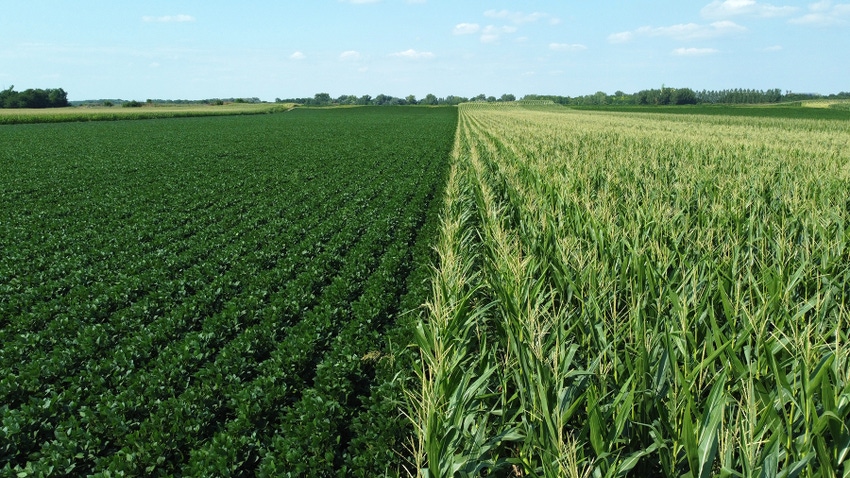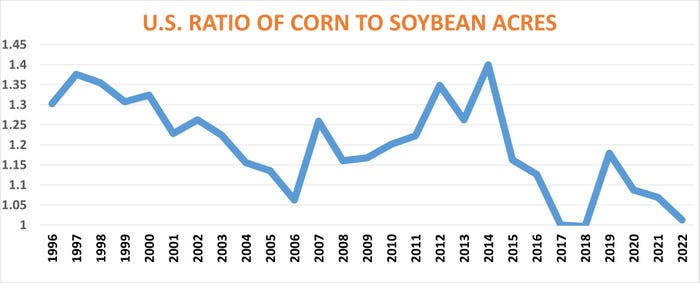
Corn and soybean farmers too often feel like pawns in chess game played by faceless corporations and greedy speculators, victims of traders who ignore the growers actually putting their money and safety at risk. Whether you think markets are rigged or simply beyond your control, take heart. It’s your turn for the spotlight. Planting decisions producers finalize in coming weeks dominate spring market maneuvers before weather ultimately takes over come summer.
First on the calendar is USDA’s March 28 Prospective Plantings, followed the next week by Crop Progress reports detailing how fast fields are seeded. Market swings, especially in new crop corn and soybean futures, drive the debate about whether prices will cause changes in farmers’ initial plans, with the wild card of weather always lurking in the wings.
True 50-50 rotations, at least nationally, were always something of a myth, though that split was achieved nationwide in the U.S. in 2017 and 2018, and nearly in 2022. Over the past 30 years Illinois is the only state in the Corn Belt to hit that metric, achieving it twice, in 1998 and again in 2022. A few others came close; otherwise, shifts from year to year, some of them seismic, are the rule, not the exception. Since 1996, when “Freedom to Farm” began loosening government program restrictions, growers seem to embrace planting what could make them the most money.
That begs the question: Does it really pay to vary corn/soybean rotations? Or are farmers better off sticking to rotations, planting the same as they did the decade or year before, or even the same mix they did way back before that landmark 1996 Farm Bill?

The answer is…
Overall the answer is “yes.” On average in the U.S., shifting rotations generated revenues 10% higher than sticking to rotations from 1996-2022. Over the past decade the shifting advantage was even better at 15%.
But revenues are only part of the equation. Costs also matter and on a net basis changing rotations isn’t quite so attractive. Still, shifters made 9% more over the past decade and 4% more from 1996-2022 nationwide.
To be sure, a shift some years seems inevitable, regardless of what markets are saying. Conserving capital by planting cheaper soybeans instead of corn may make sense to keep operating debt from exploding if cash is tight. And weather can push corn planting far too late to avoid excessive yield drag or crop insurance restrictions. Irrigated growers may also contend with pumping restrictions, based on drought or political decisions to divert crucial water supplies to consumers in thirsty cities across the West.

Location, location
Where you farm makes a difference too. Revenue benefits were less in the heart of traditional corn country. Illinois, Iowa, Indiana and Ohio saw gains of less than 10% from shifting acreage compared to sticking to rotations. Their northern neighbors – Michigan and Minnesota – improved revenues around 28% to 35%. States just to the south and west, Missouri and Nebraska, generated results around 30% to 35% better. To the north, the advantage in South Dakota ranged from 65% to nearly 80% depending on the time period used to define “original” rotations.
But by far the biggest beneficiary appeared to be Kansas, home to the author of the legislation, Sen. Pat Roberts. Revenues om the Sunflower State from acreage shifts were double or more compared to sticking to the same old, same old.
Like other states to the north, west and south of the three “I” states, the crop mix in Kansas underwent dramatic changes as farmers planted less wheat, giving them even more latitude in their planting choices once farm program restrictions eased.
The only state winding up in the red from this analysis was Wisconsin, where the disadvantage was 8% to 10% less. The reason why this was true in this admitted limited study wasn’t immediately apparent. Due to its large dairy sector, the state cuts more of its corn ground for silage, though historical percentages of harvested to planted acreage were factored into results.

Do your math
But don’t take my word for it. Planting is still a ways off, despite the warmer temperatures seen recently. So what’s your track record when it comes to planting more of one crop and less of another? Comparing whether your own business would have been better off making different planting choices makes sense. Keeping tabs on your own results is the best way to determine which path may be better: altering crop mixes annually or just sticking with the same rotation, factoring in your own experience with yield and cost benefits, considering both local economics and agronomics.
Of course, many of these decisions are already locked in for 2024, and likely have been since last fall. Still, most farms have some swing acres in play. Or at least that’s what the market believes, as it tries to get inside your heads to figure out what seed bags growers are actually opening to put in their planters.
Sure, lots of supposedly real-time data on this will be floating around, including seed company sales data, satellite imagery and results from GPS monitors. But truth is, nobody knows precisely. That’s why planting season is the one time of year when farmers have more power over all the other actors in the market. So get ready to take your bow on center stage.
About the Author(s)
You May Also Like






